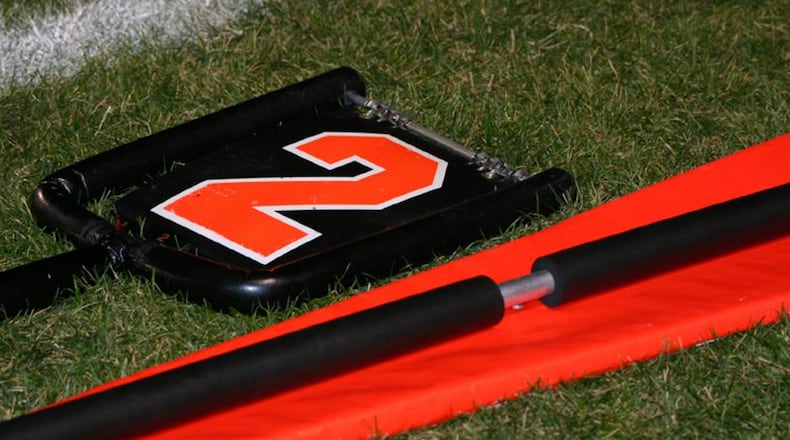GHSF Daily is expanding its Four Questions feature this season beyond head coaches to other voices in high school football. Today's interviewee is Dr. Matthew Stewart, an orthopedist for the Hughston Clinic in Georgia. Stewart is a Columbus native and former Columbus High football player who studied at Auburn, the Medical College of Georgia and Duke University.
Dr. Matthew Stewart, orthopedist
1. What are the most common football injuries that you treat and why? "I practice general orthopedics but spent an extra year of training specializing in foot and ankle surgery, so the vast majority of sports-related injuries I see involve the foot and ankle. As expected, football can be very rough on our lower extremities, especially the foot and ankle. The vast majority of injuries are ankle sprains, injuries to tendons, ligaments, and fractures. Often times an experienced trainer can handle some of the minor sprains and strains and I'll see the more severe cases or injuries that require surgery. A few of the most common injuries requiring surgery in a high-performing athlete are Achilles tendon ruptures, chronic ankle instability that develops after severe ankle sprains, fractures of the ankle, fractures of the fifth metatarsal (Jones fracture), peroneal tendon tears, turf toe and torn ligaments in the midfoot (Lisfranc injury)."
2. Most coaches and trainers do a good job keeping their players safe, but is there any advice you'd give that might help them do a better job? "I think that many coaches and trainers are astute to pick up injuries to the knees and, more recently, concussions. That's probably because these injuries, especially concussions, have gotten a lot more press as of late. That being said, injuries to the ankle and turf toe were the second- and third-most common injuries in one study of college football players, so it's important to be tuned in to these injuries as well. It's a fine line to walk with preventive measures such as taping and more supportive shoe wear that protects the foot and ankle while also not sacrificing speed and traction afforded with more lightweight and flexible cleats. From a historical standpoint, we've seen instances where there has been a sharp rise in foot and ankle injuries based on changes in athletic equipment or playing surfaces. Most famously, there was a sharp rise in turf toe injuries that occurred starting in the 1970s as more fields switched to more durable and cost-effective artificial turf. Fortunately, advances in turf, shoe wear and orthotics have come a long way, and the number of these injuries has declined.
"My best advice in regard to prevention would be evaluating each athlete's feet and alignment prior to the season. There are many athletes who were born with subtle versions of a high-arched foot known as a 'subtle cavovarus foot' deformity. Because their foot is over-supinated, these athletes are highly susceptible to injuries to their lateral ankle and hindfoot, including severe ankle sprains, peroneal tendon injuries and fifth metatarsal fractures."
3. How does football compare to other sports in terms of the risk of injury? And are you concerned that football is becoming too dangerous given what's been learned about the long-term effects of concussions? "In terms of overall foot and ankle injuries, I don't see a higher number of injuries with football, though the severity of injury can be worse. That's just the nature of a contact sport, especially one that involves running full speed at each other with the goal of blocking and tackling.
"As far as concussions go, it's obvious the effect that multiple head injuries can have long-term for players at the professional level, but I think the jury is still out on the long-term effects it has on kids who played at a high school level or lower. We just don't know yet if there's a threshold to the number of hits and how ferocious they have to be to cause CTE. The research is also inconclusive as to whether or not earlier exposure to tackle football increases the risk of cognitive or behavioral problems down the road. I do see a tremendous benefit in the recent publicity around concussions though, as many trainers and medical professionals are much more adept at recognizing signs and symptoms and making sure those players are removed from the game. On a player level, there has been a tremendous effort from coaches to teach proper ways of tackling to take the head out of the equation, and equipment is getting better and better each year."
4. If you were invited to do a brief talk to football coaches and parents on one subject, what would it be and why? "I would probably talk about recent advancements in foot and ankle surgery and rehabilitation that have allowed players to safely return to the field in a much quicker fashion. We've seen with severe ankle sprains, Achilles tendon ruptures and syndesmotic injuries that we are now able to advance their rehab after surgical repair much more quickly. This is due to stronger implants, improved surgical techniques and better rehab protocols post-operatively. Injuries that used to require many weeks and even months of immobilization in a cast are now starting range of motion almost immediately after surgery. Where they often times required long periods of non-weight-bearing for 6-12 weeks, now they are weight-bearing 2-4 weeks after surgery once their incisions heal. That's the most exciting thing from a surgeon's perspective, to safely return a player back to the field in less than half the time that it may have taken a generation ago."
Produced by Georgia High School Football Daily, a free e-mail newsletter. To join the mailing list, click here.
About the Author
The Latest
Featured

